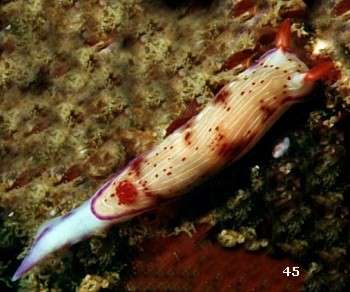
Hypselodoris carnea
(Bergh, 1889)
Order: NUDIBRANCHIA
Suborder: DORIDINA
Superfamily: EUDORIDOIDEA
Family: Chromodorididae
DISTRIBUTION
Natal Coast of South Africa, Mauritius.
PHOTO
South Coast KwaZulu-Natal, SOUTH AFRICA. Near Port Shepstone, 20 - 25m, 45mm long, October/November 1999. PHOTO: Valda Fraser. See further photos below.
RELATED TOPIC
Very similar in colour to Hypselodoris capensis but with rather different radular morphology. See correspondence from Valda Fraser and Terry Gosliner below.
Reference:
• Gosliner, T.M. & Johnson, R.F. (1999) Phylogeny of Hypselodoris (Nudibranchia: Chromodorididae) with a review of the monophyletic clade of Indo-Pacific species, including descriptions of twelve new species. Zoological Journal of the Linnean Society, 125: 1-114.
Rudman, W.B., 1999 (December 10) Hypselodoris carnea (Bergh, 1889). [In] Sea Slug Forum. Australian Museum, Sydney. Available from http://www.seaslugforum.net/find/hypscarn
Related messages
Re: Hypselodoris carnea? from the Gulf of Kutch, India
November 20, 2009
From: Dishant Parasharya
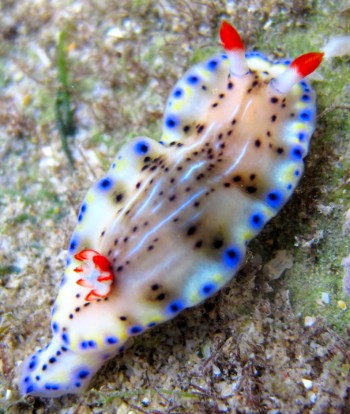
Concerning message #19388:
Dear Dr. Bill,
Got this species on 4th November 09. However I am working on the opisthobranchs in this area, but didn't get this species during my work. It looks like Hypselodoris sp. kindly guide me in the same. This is the only specimen I found.
Locality: intertidal rock pool with 70% algal cover, 15 cm, Dwarka, Gulf of Kutch,
Gujarat, India, Arabian sea, 4/11/2009, rocky. Length: 25 mm. Photographer: Vinod s Gajjar.
Dishant Parasharya
dparasharya@gmail.com
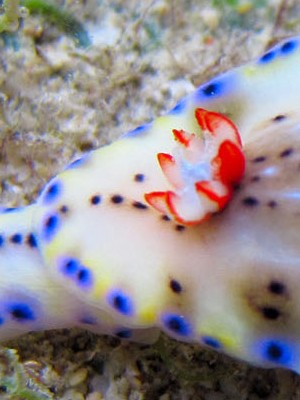

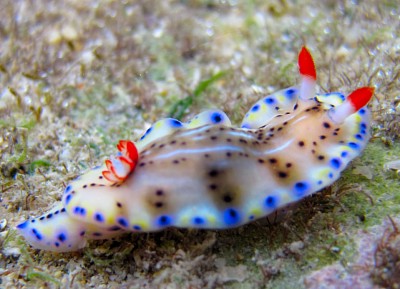
Dear Dishant,
Your animal is almost identical in colour to Brian Mayes photo from Oman [message #19677] which I identified as Hypselodoris carnea.
Yours has fewer white lines than the Oman animal but that is a link to the multi-lined animals from South Africa. Another similarity are the dark translucent brown patches with black spots along each side of the mantle which are present in all specimens. The main difference is the colour of the mantle edge. The yellow is absent in southern animals and the blue has changed to a deep purplish plum colour. But Colin Ogden [message #21508] has shown is colour variants from South Africa which have a submarginal band of yellow which could be the ornage of the yellow spots in your animal. Chromodoris aureopurpurea shows a similar shift in yellow.
I could turn out to be quite wrong but we still have a lot to learn about variation in both these white-lined chromodorids and in the blue and yellow spotted Hypselodoris infucata group of species..
Best wishes,
Bill Rudman
Re: Variations in Hypselodoris carnea
April 14, 2008
From: Colin Ogden

Concerning message #21508:
Hi Bill, thanks for your prompt response.
I do have another photo of the H. carnea showing a bit more of the yellow sponge. It appears to me that there is a small layer of another sponge on top of the yellow sponge, but it also looks as if the Hypselodoris has its mouth extended into the yellow sponge, and part of this extension is translucent and appears to have some of the yellow sponge inside.
Locality: Sodwana , 14 metres, South Africa, Indian, Jan 2008, reef. Length: 40 mm. Photographer: Colin Ogden.
I hope this can help
Regards
Colin
scubaco@iafrica.com
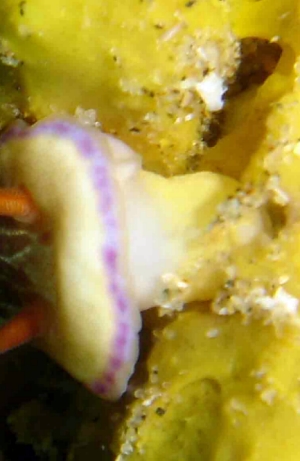
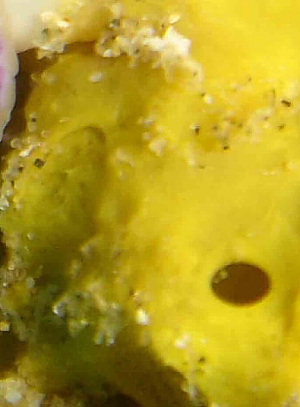

Dear Colin,
I'm afraid I can't contribute much at this stage. The yellow seems to be a thin layer, but I am not sure if the 'sand-grainy' material beneath is part of the colony or not. Some of these non-spicuate sponges incoporate sand grains into their skeleton. I will of course discuss it with my sponge expert, Dr Pat Bergquist, but even if we can't make a positive identification, it will certainly be a useful bit of information if we find it on a bright yellow sponge in future. Perhaps next time its stucture will make it a little more identifiable.
Best wishes,
Bill Rudman
Re: Variations in Hypselodoris carnea
April 10, 2008
From: Colin Ogden
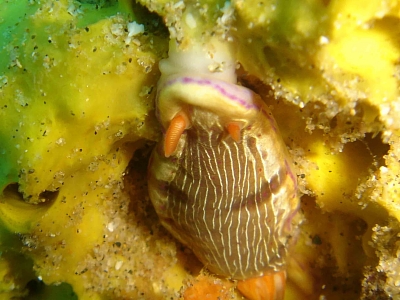
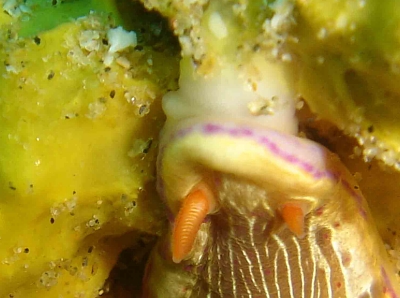
Hi Bill,
On a dive a couple of months ago I came across this Hypselodoris carnea [upper photos] feeding on a sponge that appears to me to be different from the sponge in the lower photo, which I sent to you in an earlier message [#15008 ]. We have a huge variation in their colours, and if this is a different sponge maybe their colour variation depends on their food source. I am sorry that I know so little about sponges and just wish that I could improve my knowledge in this field.
Locality: Upper photos: Sodwana Bay, 14 metres, South Africa, Indian, 15 Jan 2008, reef. Length: 40mm. Lower photo: Sodwana Bay, 10 metres. Length: 3 cm. 12 October 2005. sponge algae reef. Photos: Colin Ogden.
best regards
Colin Ogden
scubaco@iafrica.com
Ogden C. M., 2008 (Apr 10) Re: Variations in Hypselodoris carnea. [Message in] Sea Slug Forum. Australian Museum, Sydney. Available from http://www.seaslugforum.net/find/21508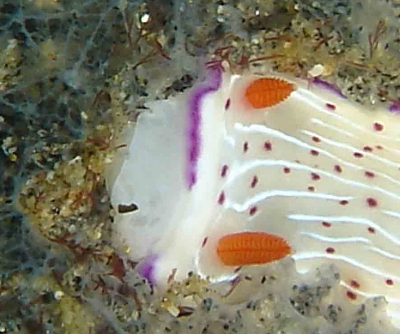
Dear Colin,
It certainly looks as though the brown background colour in your upper photos is from the internal digestive gland and the yellowish band around the mantle edge could possibly be the result of mantle gland contents.
Concerning the yellow sponge which your animal looks to be feeding on. I am afraid I can't see any structural details which I can use. Amost all species of Hypselodoris feed on species of Dysidea, or related genera, and like the sponge in the lower photo the colony has cone-like shapes all over and a radiating pattern and network of structural fibres which are usually quite obvious. Although at times the colonies can be reasonably large and thick, often they consist of a very thin layer over the substrate, or over another sponge colony. It's possible in this case that the sponge the slug is eating is a fine layer over the yellow sponge which we can't really see, but I really can't say. It would be interesting to see what the sponge cover looked like just above the slug? If you have a photo showing just a bit more above the slug it might be useful. As to learning more about sponges, I'm afraid there is not an easily available general book, and no easy way for amateurs - or non-sponge specialists - to identify most sponges. This is for a host of reasons, not the least being that there is still a lot of research needed to sort out sponge taxonomy. Another big problem is that sponge colonies are often very variable in shape and even colour and so species can often only be identified by cutting sections through the tissue for microscopic examination. In sponges with skeletal spicules, we need to examine not only the shape of the spicules, but how they are arranged in the sponge colony. Most sponges eaten by chromodorids present even greater problems because they lack spicules, so we are left with examining the arrangement of the fibrous network to determine species and families. My advice is to try and become familiar with your local sponge fauna even if you can't actually name species. If you find slugs taking a particular interest in particular sponges, keep taking photos of both the sponge and the slug. It is proving an invaluable help.
Thanks very much,
Bill Rudman
Re: Thorunna florens from sthn Queensland
September 28, 2007
From: Colin Ogden
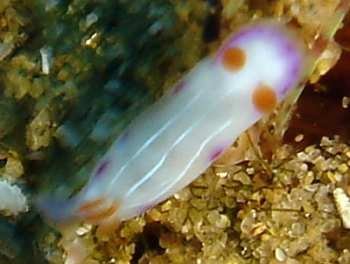
Concerning message #20783:
Hi Bill,
Following on Gary Cobb's message, I took this photo 3 days ago, and put it into my query file. Could this be a Thorunna florens as well? Although it has 3 stripes instead of 2 on its mantle, and lacks the orange marking on the front tip of its mantle, every thing else seems to be similar. Sorry about the quality of the photo, but it was very small.
Locality: Sodwana Bay, 18 metres, South Africa, Indian, 23 september 2007, reef. Length: 6 mm. Photographer: Colin Ogden.
I find it fascinating to follow the current messages on the forum, and often they help me ID some of my query nudi's. Thanks a ton for all the work you do.
regards
Colin
scubaco@iafrica.com
Ogden C M, 2007 (Sep 28) Re: Thorunna florens from sthn Queensland. [Message in] Sea Slug Forum. Australian Museum, Sydney. Available from http://www.seaslugforum.net/find/20830Dear Colin,
It's a good photo at 6 mm in situ. My guess is that this is a juvenile of either Hypselodoris carnea or H. capensis. In colour it looks more like H. capensis, but since that species seems to be restricted to the temperate Cape region, my guess is that your animal is a very juvenile H. carnea.
Best wishes,
Bill Rudman
Hypselodoris carnea from Oman
April 12, 2007
From: Brian Mayes
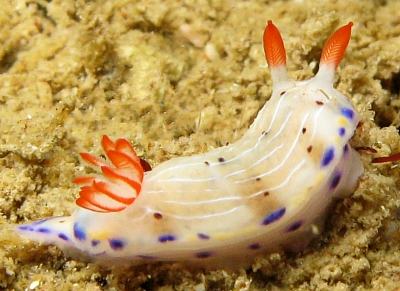
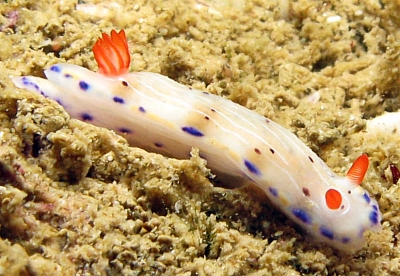
Hi Bill,
I'm having difficulty in deciding if the attached photos are of Hypselodoris capensis or H. carnea. Due to the broken purple margin around the anterior end and the slight pink body, I feel it is more likely to be capensis, but for geographical reasons carnea seems more likely. What do you think?
I found it on a dive site called "Cockle Shell Bay" in Bandar Khairan, near Muscat in the Gulf of Oman.
Locality: "Cockle Shell Bay", Bandar Khairan, near Muscat, 16 metres, Oman, Gulf of Oman, 01 March 2007, Silty reef. Photographer: Brian Mayes.
Best Regards
Brian Mayes
brian@mayescai.freeserve.co.uk
Mayes, B.R., 2007 (Apr 12) Hypselodoris carnea from Oman. [Message in] Sea Slug Forum. Australian Museum, Sydney. Available from http://www.seaslugforum.net/find/19677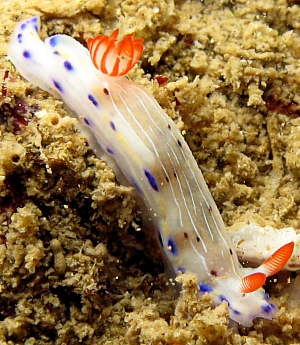
Dear Brian,
As you will see from the various discussions in messages concerning these two species, you are not the only one who has difficulties in distinguishing them externally. I guess the simplest difference is that H. capensis is a cool temperate species and H. carnea has a tropical distribution, at least in the Indian Ocean. On those grounds your animal is H. carnea.
Best wishes,
Bill Rudman
Variations in Hypselodoris carnea
October 14, 2005
From: Colin Ogden
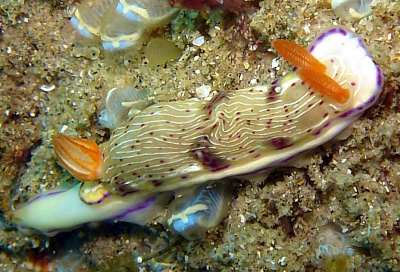
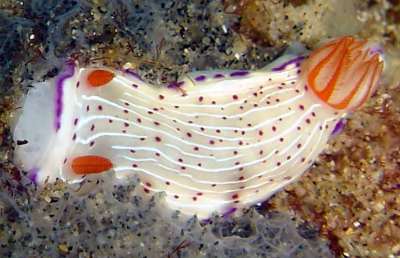
Hi Bill,
this morning a took these photos of 2 Hypselodoris carnea. The variation is quite substantial. The first photo shows a very colourful patch on the mantle just behind the gills, while the second photo is a more common appearance.
Locality: Sodwana Bay, South Africa, Indian Ocean coast. Depth: 10 metres
Length: 3 cm. 12 October 2005. sponge algae reef. Photographer: Colin Ogden
Regards
Colin
scubaco@iafrica.com
Ogden C. M., 2005 (Oct 14) Variations in Hypselodoris carnea. [Message in] Sea Slug Forum. Australian Museum, Sydney. Available from http://www.seaslugforum.net/find/15008
Dear Colin,
My first thought was that you had Hypselodoris carnea and the very similar looking H. capensis, but the locality would seem to preclude that. The bright patch seems to be something to do with the colour of the mantle glands, which in Hypselodoris are often much larger behind the gills. What you didn't mention is that the second specimen is nestled into a colony of a sponge (Family Dysideidae) which is almost certainly its food sponge. I am pretty sure, in this case, that the white mass at the front of the body is its everted buccal bulb. A nice new feeding record!
Best wishes,
Bill Rudman
Hypselodoris carnea retracting its gills with H.infucata
September 5, 2005
From: Colin Ogden
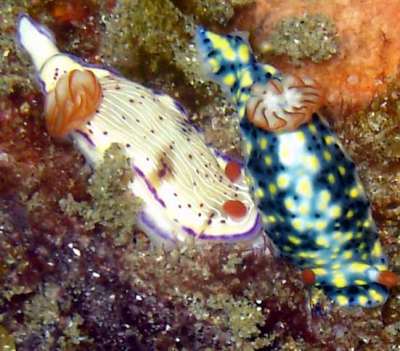
Hi Bill,
The other day I found what I think is a H. carnea feeding together with a H. infucata. In the 1st photo the H. carnea has its gills extended, but in the second photo it has retracted its gills. Is this normal?
Locality: Sodwana Bay, South Africa. Indian Ocean coast. Depth: 12 metres. Length: 35 mm. August 2005. Coral reef. Photographer: Colin Ogden
Regards
Colin
scubaco@iafrica.com
Ogden C M, 2005 (Sep 5) Hypselodoris carnea retracting its gills with H.infucata. [Message in] Sea Slug Forum. Australian Museum, Sydney. Available from http://www.seaslugforum.net/find/14635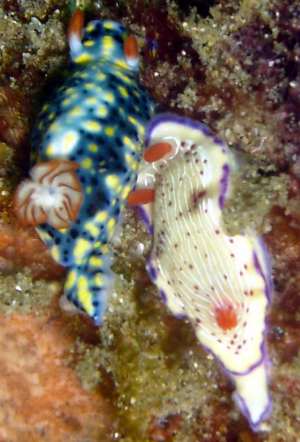
Dear Colin,
I am pretty sure this is Hypselosoris carnea. Terry Gosliner says, that the very similalr looking H. capensis doesn't extend up the Natal coast. Concerning the gills conracting. This is entirely normal for one major group of the dorids, which has a chamber into which the gill circlet is able to retract. The higher classification of the dorids is under quite extensive research at the moment but in the past the dorids have been divided in to two superfamilies called the Cryptobranchia [= Eudoridoidea] and the Phanerobranchia [=Anadoridiodea]. - Crypto = hidden, Phanero = naked, branchia = gills. As the name suggests the other major group of dorids, the Phanerobranchia have gills that can contract, but don't have a pocket to retreat into.
Best wishes,
Bill Rudman
Hypselodoris cf carnea from South Africa
January 6, 2001
From: Valda Fraser
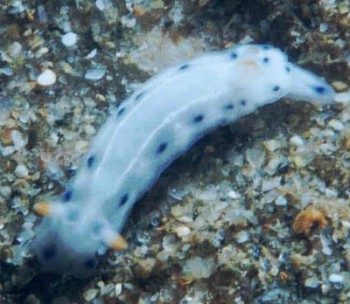
Dear Bill
Please help with identification. Much appreciated.
Locality: Aliwal Shoal, Umkomaas, KwaZulu-Natal, SOUTH AFRICA, 15m
Date: July 2000
Size: 10mm
Thanks.
Valda Fraser
iti04937@mweb.co.za
Dear Valda,
I am pretty sure this is a species of Hypselodoris and my first guess would be that it is a juvenile of one of the terrible twins, Hypselodoris carnea and H. capensis. The orange band on the rhinophores and the orange-edged gills fit that species and the pair of white lines on the mantle could easily be the beginnings of the multiple white lines which typify both species.
Then again it could be something else.
Best wishes,
Bill Rudman
Hypselodoris carnea from Oman
December 24, 2000
From: Gordon T. Smith
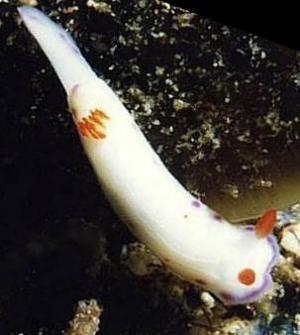
Dear Bill,
Welcome back to the cyberworld. I have been contacted by Chris Mosely through some friends of mine to identify the enclosed picture of a nudibranch photographed in southern Oman near Salalah.
It was about 2.5-3.0 cm in length, and found around 6-10 metres.
With best regards
Gordon T. Smith
aquashot@emirates.net.ae
Smith, G.T., 2000 (Dec 24) Hypselodoris carnea from Oman. [Message in] Sea Slug Forum. Australian Museum, Sydney. Available from http://www.seaslugforum.net/find/3387Dear Gordon,
At first glance I thought of Thorunna daniellae but apart from other considerations, I think there are clear signs of longitudinal opaque white lines on the mantle which would suggest a pale form of Hypselodoris carnea.
I would welcome anyone else's ideas
Best wishes,
Bill Rudman.
Hypselodoris capensis & H. carnea
July 28, 2000
From: Bill Rudman
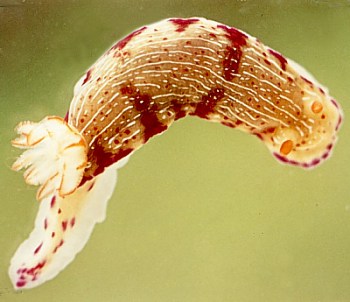
I recently found two photos I was sent some years ago from South Africa of two species of Hypselodoris. I had been unable to decide whether they were both Hypselodoris capensis or Hypselodoris carnea, or one of each. I have asked Terry Gosliner's opinion and he considers that this one is H. carnea and the other, which I have posted on a separate page is Hypselodoris capensis.
This animal was collected in an intertidal pool, Algoa Bay, Eastern Cape, nr Port Elizabeth, South Africa. 15mm long alive, 1973. Photo: Robin Stobbs.
Algoa Bay must be a region where the geographical distributions of the cool temperate H. capensis and the tropical H. carnea overlap/
They are clearly very difficult to distinguish externally.
Bill Rudman.
Rudman, W.B., 2000 (Jul 28) Hypselodoris capensis & H. carnea. [Message in] Sea Slug Forum. Australian Museum, Sydney. Available from http://www.seaslugforum.net/find/2785Re: Hypselodoris carnea v. capensis
December 16, 1999
From: Terry Gosliner
Dear Bill,
To clarify my earlier message I am virtually certain that all of Valda's photos are of H. carnea, not of H. capensis. I dissected a bunch of animals to try to resolve the differences
when I was in South Africa and I never had a single H. capensis from Natal.
Terry
tgosline@CalAcademy.org
Gosliner, T., 1999 (Dec 16) Re: Hypselodoris carnea v. capensis. [Message in] Sea Slug Forum. Australian Museum, Sydney. Available from http://www.seaslugforum.net/find/1681Thanks Terry,
It would be intersting to know whether they feed on different sponges, or whether their egg ribbons differ. Not that that would help identify them from photos. I'll place them all under H. carnea. If you have a chance, a photo of H. capensis would be a nice comparison to add to the Forum for those without access to your book.
Bill Rudman.
Hypselodoris capensis v H. carnea
December 11, 1999
From: Valda Fraser

Dear Bill
Gosliner (1987. Nudibranchs of Southern Africa, Sea Challengers, Monterey, California, p81) indicates that Hypselodoris capensis and H. carnea differ in radular structure. However, external differences allow differentiation "with H. capensis possessing much more pink or brownish pigment and having a discontinuous purple margin at the anterior end of the head."
This description has not enabled me to differentiate between the two species. Is the marking on the foot not at issue?
What do you make of the photos I've included?
Locality: South Coast KwaZulu-Natal, SOUTH AFRICA. Near Port Shepstone, 20 - 25m, October/November 1999.
45 = 45mm; 46 = 35mm; 47 = 55mm
Regards
Valda Fraser
iti04937@mweb.co.za

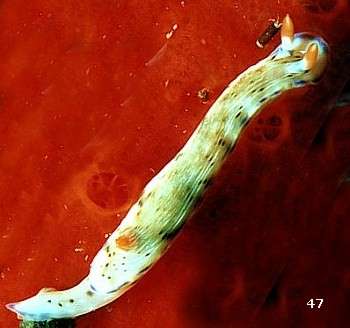
Dear Valda,
Looking at both Terry's book and the recent Hypselodoris paper I must agree that there seem to be no good colour distinctions.
I also looked at presence and absence of spots on the foot. In Terry's book H. carnea has spots on the foot and H. capensis doesn't. However my guess would be that your 45 & 47 are both H. carnea and one has foot spots and the other doesn't. I don't know if spots on the mantle behind the gills is important but your 45, 47 and Terry's H. carnea have mantle spots behind the gills and his H.capensis and your 46 do not.
Gosliner & Johnson (1999) identify the photos of H. carnea (p.235) and H. capensis (p.234) in Debelius, 1996 as H. carnea.
Hopefully Terry will take pity on us and let us know what he thinks.
Cheers,
Bill Rudman.
Reference: Gosliner, T.M. & Johnson, R.F. (1999) Phylogeny of Hypselodoris (Nudibranchia: Chromodorididae) with a review of the monophyletic clade of Indo-Pacific species, including descriptions of twelve new species. Zoological Journal of the Linnean Society, 125: 1-114.
Rudman, W.B., 1999 (Dec 11). Comment on Hypselodoris capensis v H. carnea by Valda Fraser. [Message in] Sea Slug Forum. Australian Museum, Sydney. Available from http://www.seaslugforum.net/find/1661